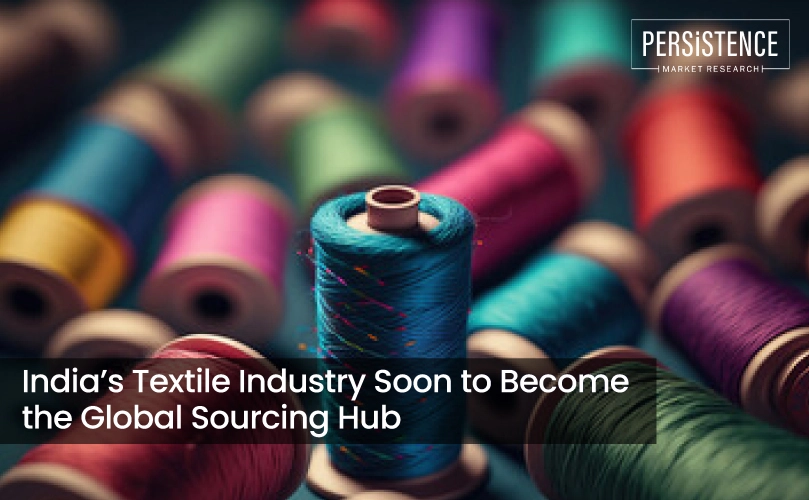- Blog
- India Textile Industry
India’s Textile Industry Soon to Become the Global Sourcing Hub
Published On : 7 Jan 2025
India has long been a global leader in the textile industry, with a rich tradition of textile manufacturing that dates back centuries. Over the years, the sector has evolved significantly, combining traditional craftsmanship with cutting-edge technologies to meet both domestic and international demand.
India is now considered one of the most significant producers and exporters of textiles worldwide. The country is also at the forefront of shaping the future of the textile industry. In recent years, the focus has shifted to the development of emerging textile zones, technological innovations, sustainability, and government support. All of these are driving the sector's growth and positioning it for greater success.

India’s textile industry is uniquely positioned to cater to both global and local needs- right from raw materials to finished garments. The government's initiatives, such as the ‘Make in India’ and ‘Atmanirbhar Bharat’ campaigns, have propelled the development of unique textile parks and Special Economic Zones (SEZs).
Such zones aim to provide state-of-the-art infrastructure, tax incentives, and a conducive environment for domestic and foreign investments. The emergence of these textile zones across key states in India like Gujarat, Maharashtra, Tamil Nadu, and Telangana, is a significant factor in the country’s rapid rise as a global textile hub.
The aforementioned states are leveraging their geographical advantages, skilled labor, and raw material availability to enhance textile manufacturing capabilities. They are also shifting toward sustainable practices and technological innovations.
Leading Brands to Develop Sustainable Technologies to Gain Competitive Edge
New developments in the India textile industry reflect both the innovation-driven focus and the sector’s commitment to growth. Companies are integrating unique technologies such as artificial intelligence, automation, and 3D printing into their operations. A few notable examples are given below-
- Grasim Industries
One prominent example is the emergence of Grasim Industries, a subsidiary of Aditya Birla Group. It has been constantly investing in sustainable high-performance fibers, particularly in the production of viscose staple fibers.
Grasim's commitment to sustainability is evident through its use of eco-friendly production processes and efforts to reduce its environmental footprint. These steps are aligning with the rising shift toward more responsible textile production?.
- Arvind Limited
Arvind Limited, a key player in India's textile and apparel manufacturing sector, is embracing innovation by integrating smart fabrics and sustainable practices into its portfolio. The company is focusing on the production of high-performance textiles such as moisture-wicking fabrics and UV-protection textiles. These have become highly sought after in markets worldwide. Arvind’s emphasis on sustainability is also reflected in its efforts to reduce water usage and adopt renewable energy solutions at its manufacturing plants?.
- Raymond Limited
Another noteworthy development is the rise of Raymond Limited, which is diversifying into new textile markets such as technical textiles. The firm’s push to enter this specialized segment highlights the rising importance of value-added products in India’s textile industry. With increasing demand for high-performance textiles in industries like automotive, healthcare, and construction, Raymond's expansion into these fields positions it as a leader in innovation and diversification?.
India Sees Emergence of Start-ups with Trend for Eco-friendly Fabrics and Innovations
While established giants continue to dominate the textile sector, start-ups are also playing a key role in driving innovation. Econserve, a start-up focused on sustainable textile solutions, is pioneering eco-friendly nonwoven fabrics made from recycled plastics.
The materials are not only reducing waste but also providing an alternative to conventional textiles that are harmful to the environment. The company’s innovations in biodegradable fabrics have been well-received by eco-conscious consumers and industries alike. These are further pushing India’s textile industry toward a more sustainable future?.
India’s textile industry is also benefiting from the increasing integration of Internet of Things (IoT) and AI technologies. Companies are using AI-driven data analytics to optimize supply chains, reduce production time, and forecast consumer demand more accurately. This technological leap is helping businesses to remain competitive in a booming market that increasingly requires efficiency, quality, and fast turnarounds?.
India-based Companies to Focus on Smart Textiles and Automation in Future
India's textile industry is experiencing a transformative phase, with the rise of emerging textile zones and new company developments shaping its trajectory. These textile hubs, supported by both government initiatives and private-sector investments, are paving the way for the country to strengthen its position as a global textile leader.
Companies like Grasim Industries, Arvind Limited, and Raymond Limited are adopting innovative, sustainable, and technology-driven practices. Hence, the local textile sector is not only focusing on extending its manufacturing capabilities but also enhancing its global competitiveness.
The ongoing focus on smart textiles, sustainable practices, and automation is creating a forward-thinking, resilient industry that is ready to meet the challenges of the 21st century. As these developments continue to unfold, the India textile industry will remain a key player in the global economy. It is estimated to deliver high-quality products that cater to a diverse range of needs while contributing to global sustainability efforts.
Industry Report

Non Wovens Market
Nonwoven Fabric Market by Technology (Spun Bond, Wet Laid, Dry Laid), by Material Type (Polyester, Polypropylene, Polyethylene, Rayon), by Application (Personal Care and Hygiene, Filtration, Healthcare, Automotive, Building and Construction), and Regional Analysis
Read MoreGet A Report Sample
Latest Reports
-
Edible Offal Market By Product Type (Liver & Kidneys, Tripe & Tongue, Others), Animal Source (Bovine, Poultry, Others), Distribution Channel, and Regional Analysis for 2025 - 2032
-
Automatic Tube Labelling System Market By Product Type (Fully Automatic Systems, Semi-Automatic Systems), End-user (Clinical Laboratories, Hospitals, Other), Label Type, and Regional Analysis for 2025 - 2032
-
Automotive Digital Key Market Segment by Product type (Smart Keyfob, Key Card and Smart Watch), by Vehicle Type (Passenger Cars, LCVs and HCVs), by Sales Channel (OEMs and Aftermarket)), and Region for 2025 - 2032
-
DC-DC Converter Market By Form Factor (Through-Hole/SMD, Brick Modules, Others), End-user (Electric Vehicles (EVs), Renewable Energy, Others), Material (Gallium Nitride (GaN), Silicon Carbide (SiC), Silicon, Others), and Regional Analysis for 2025 - 2032
-
LoRa Gateway Module Market By Deployment Model (Private Networks, Others), Component (Software, Services, Hardware), End-user Application (Smart Cities, Industrial Automation, Smart Metering, Others), and Regional Analysis for 2025 - 2032
Contact Us
